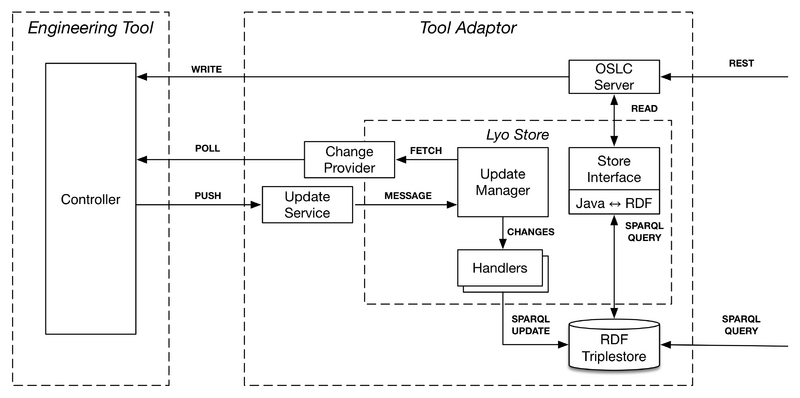Notice: this Wiki will be going read only early in 2024 and edits will no longer be possible. Please see: https://gitlab.eclipse.org/eclipsefdn/helpdesk/-/wikis/Wiki-shutdown-plan for the plan.
Lyo/Store
Lyo Store
Lyo Store is a library that provides a simple interface for working with a triplestore via Java objects representing OSLC Resources.
Introduction
Lyo Store makes use of the Jena Framework API (through the Eclipse Lyo Jena helper) to interact with any RDF Triplestore that can provide a SPARQL endpoint over HTTP.
An OSLC Server interacts with Lyo Store using on instances of OSLC4J-annotated classes, which are expected to represent the business objects of the underlying lifecycle tool. This allows the Server components to work generically with any tool Controller, while at the same time being able to handle tool-specific domain objects. When interacting with the RDF TripleStore, Lyo Store eventually marshals/unmarshals such instances into an RDF graph, through the available OSLC4J helper methods.
So naturally, all components of this architecture need to share the common set of OSLC4J-annotated classes. To facilitate this effort, the adaptor developer can take advantage of the OSLC Lyo Modelling tool in order to graphically model the business objects to be exposed, as well as the services of the OSLC Server component. From such a model, the classes and services can be generated.
Getting started
Lyo uses Maven as a primary choice for the build system. Make sure your POM file includes Eclipse Maven repositories (see the OSLC4J instructions).
Add the following dependency:
<dependency> <groupId>org.eclipse.lyo.tools</groupId> <artifactId>lyo-store</artifactId> <version>2.2.0-SNAPSHOT</version> </dependency>
NOTE! If you are using the older versions of Lyo (2.1.2 and lower), Maven might decide to use an incompatible version of Jena (eg you get the java.lang.NoClassDefFoundError: com/hp/hpl/jena/graph/NodeFactory). In order to prevent this, enforce the Jena version used by lyo-store by adding the following tag to the pom.xml:
<dependencyManagement> <dependencies> <dependency> <groupId>org.apache.jena</groupId> <artifactId>jena-core</artifactId> <version>2.13.0</version> </dependency> </dependencies> </dependencyManagement>
Now you are all set to start using the library. If you encounter any API questions along the way, consult the Javadoc or ask a question on the Lyo forum.
Using Lyo Store
Assuming you have initialised an array of resource class instances in variable resourceArray, in order to add the new resources and overwrite the existing ones you can use the following flow:
try { store.updateResources(GRAPH_NAME, // URI of the named graph resourceArray); // an array of OSLC Resources } catch (StoreAccessException e) { logger.error("Error executing a query on a triplestore"); }
In order to retrieve the resources of type Requirement from the triplestore in batches of 200:
if (store.namedGraphExists(GRAPH_NAME)) { try { final int limit = 200; // fetch 200 resources final int offset = 0; // start with the first page // 'limit+1' is a technique that allows you to determine if there are // more results on the next page List<Requirement> requirements = store.getResources(GRAPH_NAME, Requirement.class, // resources of this class will be fetched and unmarshalled limit + 1, // resource limit offset)); // how many resources to skip, use for paging } catch (StoreAccessException e) { logger.error("Error executing a query on a triplestore"); } catch ( ModelUnmarshallingException e) { logger.error("Error unmarshalling the RDF from triplestore into Requirement class instances"); } }
See Store javadoc for all available methods.

